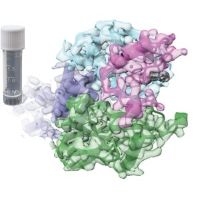Specification
| Description | Recombinant protein from the full-length sequence of homo sapiens potassium channel tetramerization domain containing 11 (KCTD11) (NM_001002914). |
| Organism | Homo sapiens (Human) |
| Expression Host | Human Cells |
| Tag Info | His or DYKDDDDK. Please contact us if you need further information or require specific designed tag. |
| Purity | Greater than 90% by SDS-PAGE gel |
| Uniprot ID | Q693B1 |
| Entry Name | KCD11_HUMAN |
| Gene Names | KCTD11 C17orf36 REN |
| Alternative Gene Names | C17orf36 REN |
| Alternative Protein Names | BTB/POZ domain-containing protein KCTD11 (KCASH1 protein) (Potassium channel tetramerization domain-containing protein 11) (RING-type E3 ubiquitin transferase subunit KCTD11) |
| Application | Antigens, Western, ELISA and other in vitro binding or in vivo functional assays, and protein-protein interaction studies; For research & development use only! |
| Buffer | Purified protein formulated in a sterile solution of PBS buffer, pH7.2, without any preservatives |
| Endotoxin | Endotoxin level is < 0.1 ng/µg of protein (<1EU /µg) |
| Length | 232 |
| Molecular Weight(Da) | 25887 |
| Protein Sequence | (The sequence of expressed protein may have some variation from the sequence shown below. Please contact us for the exact sequence.) MLGAMFRAGTPMPPNLNSQGGGHYFIDRDGKAFRHILNFLRLGRLDLPRGYGETALLRAEADFYQIRPLLDALRELEASQGTPAPTAALLHADVDVSPRLVHFSARRGPHHYELSSVQVDTFRANLFCTDSECLGALRARFGVASGDRAEGSPHFHLEWAPRPVELPEVEYGRLGLQPLWTGGPGERREVVGTPSFLEEVLRVALEHGFRLDSVFPDPEDLLNSRSLRFVRH |
Background
| Function | FUNCTION: Plays a role as a marker and a regulator of neuronal differentiation; Up-regulated by a variety of neurogenic signals, such as retinoic acid, epidermal growth factor/EGF and NGFB/nerve growth factor. Induces apoptosis, growth arrest and the expression of cyclin-dependent kinase inhibitor CDKN1B. Plays a role as a tumor repressor and inhibits cell growth and tumorigenicity of medulloblastoma (MDB). Acts as probable substrate-specific adapter for a BCR (BTB-CUL3-RBX1) E3 ubiquitin-protein ligase complex towards HDAC1. Functions as antagonist of the Hedgehog pathway on cell proliferation and differentiation by affecting the nuclear transfer of transcription factor GLI1, thus maintaining cerebellar granule cells in undifferentiated state, this effect probably occurs via HDAC1 down-regulation, keeping GLI1 acetylated and inactive. When knock-down, Hedgehog antagonism is impaired and proliferation of granule cells is sustained. Activates the caspase cascade. {ECO:0000269|PubMed:15249678, ECO:0000269|PubMed:20081843, ECO:0000269|PubMed:21237243}. |
| Pathway | Protein modification; protein ubiquitination. |
| Protein Families | |
| Tissue Specificity | Higher expression in cerebellum than in whole brain and lower expression in medulloblastoma. {ECO:0000269|PubMed:15249678}. |
QC Data
| Note | Please contact us for QC Data |
| Product Image (Reference Only) |  |

